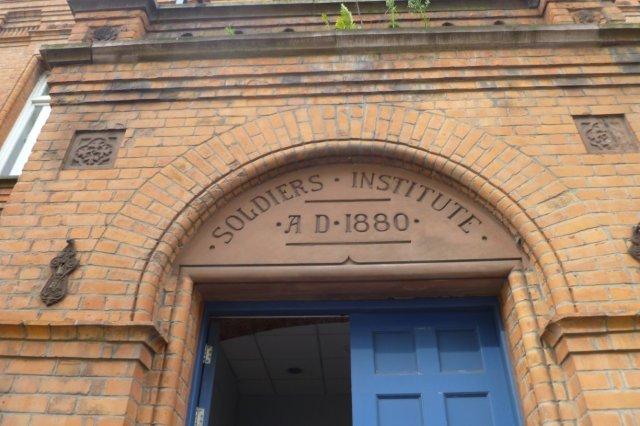‘To provide a home for the soldiers of this garrison, where they can feel that they will be free from the influence of those elements for evil which ever beset a soldiers’ path in every large city.’ 1
This was how Thoms described the Soldiers’ Home on Parkgate Street in Dublin. The picture below shows the building today.

Soldiers’ Homes in Ireland were founded and directed by Elise Sandes, a Tralee native with a passion for bringing God’s word to soldiers and sailors. (Her organisation still exists.) The ordinary British soldier was not particularly observant in spite of the mandatory religion enforced every Sunday in the Church parade. 2 The attractions of the garrison town were obvious: drink, prostitutes and gambling. These ‘elements of evil’ were not confined to large cities: Sandes Homes were built in many Irish towns, including Ballincollig County Cork, Newbridge, County Kildare and Cahir, County Tipperary. 3

Sandes Homes offered soldiers a social space where drink, loose women and gambling were prohibited. Every home provided a reading room and religious literature was freely available. The beverage of choice was tea. The Homes soon proved popular with commanding officers who appreciated the advantages of sober, respectable soldiers. Some Homes were built within the confines of the barracks, such as in Ballincollig. 4 These buildings were the least likely to survive the incendiary tendencies of Irish republicans in the 1920s.

Source: http://catalogue.nli.ie/Record/EAS_2484.
The placing of Sandes Homes within barracks illustrates just how much perceptions of ordinary soldiers had changed in the latter half of the 19th century. When the shocking conditions soldiers fought and died in during the Crimean War caused a national scandal, public pressure forced the army administration to attend more carefully to soldiers’ physical welfare. 5 As the army began to take the welfare of its soldiers’ more seriously, gymnasiums, churches and schools were built in barracks across the Empire. 6
At the root of the problem was the barracks system itself. The large barracks that were built in the 19th century segregated soldiers and civilians, in order to foster a military esprit de corps that would bind enlisted men together. Women and children were excluded from military life, with only a tiny proportion of men officially permitted to marry. Men struggled to form new families even as existing family ties to parents and siblings were severed by long service. The army deliberately created a masculine military family, focused on regimental loyalty, confined within and defined by the barracks’ wall. 7
The army took the disciplinary side of its parental duties seriously – flogging was legal until 1906 – but developing respectability and probity in the ranks was not a military objective, particularly under the command of the’ Iron Duke’, Wellington. 8
Just how successful was the army in creating a substitute military family for ordinary soldiers? The most important social space within the barracks was the mess or canteen, which served copious amounts of alcohol. Living quarters were cramped and overcrowded. To relieve the tedium of barracks life, men continued to seek solace outside the barracks gate, often turning to drink, gambling and prostitution. The economy of garrison towns benefitted but also suffered the consequences of drunken men on public streets and subsequent violence. The public perception of the soldier was so poor that many respectable men were discouraged from joining the army. 9 The army was clearly failing in loco parentis if society saw its ‘children’ as scumbags.
It was left to an Irish evangelical woman to provide some semblance of family life for soldiers. Her organisation proliferated in Ireland and India but there was no need for her Homes in Britain, where Louisa Daniell, and her daughter Georgiana, had established Soldiers’ Homes. 10 The women who ran the Homes were referred to as ‘Mother’ and embodied a type of woman that soldiers did not meet in military life. Sandes mission to soldiers was a religious one but it is unlikely that her Homes would have been popular if proselytizing was overt or oppressive. In fact, the Curragh Home served the troops of the Irish state until the 1980s, though no longer fully part of the Sandes organisation. 11 The Sandes Homes were truly a refuge from the inadequacies of barracks life as well as an alternative to dubious leisure pursuits found in garrison towns.

- Thoms Directory 1916 p 263. ↩
- See Jeremy A. Crang, ‘The Abolition of Compulsory Church Parades in the British Army’, Journal of Ecclesiastical History 56,1 (2005) pp. 92-106, for religious observance among Protestant soldiers. ↩
- A list of where Sandes Homes were built is here: http://www.sandes.org.uk/template.asp?pid=48&area=1&aName= Accessed 21 September 2012. ↩
- Postcard images show the entrance to the Home was also the East Gate of the barracks. http://ballincollig.wordpress.com/military-barracks/ Accessed 21 September 2012. ↩
- For coverage of the war in Irish newspapers see David Murphy, Ireland and the Crimean War (2002). ↩
- See Alan Skelly, The Victorian Army at Home: the recruitment and terms and conditions of the British regular, 1859-1899 (1977) for more on education and health. For sport see Tony Mason and Eliza Riedi, Sport and the Military: the British Armed Forces, 1880-1960 (2010). ↩
- For more on the gender relationships of the Victorian army see Myna Trustram, Women of the Regiment: Marriage and the Victorian Army (1984). ↩
- Flogging was no longer part of normal army discipline from 1881 – see Harry Hopkins, The Strange Death of Private White (1977) – but continued in military prisons until 1906, http://hansard.millbanksystems.com/commons/1906/mar/26/army-annual-bill#S4V0154P0_19060326_HOC_409, Accessed 21 September 2012. ↩
- James Douet, British Barracks 1600-1914: their architecture and role in society (1989) p 167. ↩
- See Kenneth Hendrikson, Making Saints: Religion and the Public Image of the British Army 1809-1885 (1998). ↩
- Bryan McMahon, ”Endynamited by Christ’: Sandes Soldiers’ Homes’ History Ireland 13, 4 (2005) http://www.historyireland.com/volumes/volume13/issue4/news/?id=113859 Accessed 21 September 2012. ↩